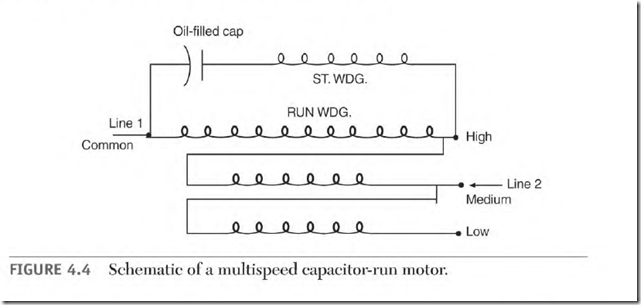Capacitor-run motors are used when high starting torque isn’t required. They are quite trouble free because of their simple design. The high-slip squirrel cage rotor is its only moving part.
The high-slip rotor is designed for high inertia loading. An example of a high inertia load is the heavy squirrel cage fan in some furnaces. The fan is mounted directly on the shaft of the capacitor-run motor. The time involved in bringing the fan up to speed isn’t a problem for the capacitor-run motor. This same type of load would seriously overheat the start winding of a split-phase motor.
Components of the Capacitor-Run Motor
The components of a capacitor-run motor are a high-slip squirrel cage rotor, an oil-filled capacitor, and a stator (with a start winding and run winding). Both start and run windings are high impedance windings, so they can start a high inertia load without overheating.
Operation of the Capacitor-Run Motor
When single-phase voltage is applied, the start and run winding are both energized. Because of the oil-filled capacitor, current flow peaks in the start winding before it peaks in the run winding, creating a rotating magnetic field. (The start and run windings are energized all the time.) These windings draw a small amount of starting current compared to a split-phase or capacitor-start motor. The start-winding current is limited by the oil-filled capacitor.
Although this motor normally runs hot, the electrical components are relatively trouble free. Its weakest components are the bearings. To be competitively manufactured, most of these motors have undersized sleeve bearings and a thin steel frame. If they are equipped with ball bearings, they tolerate angle positions better. Because of this motor’s low cost, they are replaced rather than repaired.
Multispeed Capacitor-Run Motor
Some capacitor-run motors have multiple taps, giving them multiple speeds. Lower speed selections are accomplished by adding more turns or coils between the end of the high-speed winding and line 2 (Fig. 4.4). Extra turns lower the amperes and weaken the motor’s torque. The rotor’s high-slip design allows the load to lower the motor’s speed without overheating it.
Without a load, the motor accelerates to near synchronous speed on all speed selections.
It is very important to connect the common lead to line 1 as shown in Fig. 4.4. Connecting leads high and low across the line would instantly burn the windings.
Reversible Capacitor-Run Motor
Reversible capacitor-run motors are used on low-torque loads such as house fans or dishwashers. Its schematic is shown in Fig. 4.5. Both start and run windings have the same winding data. An external switch places the oil-filled capacitor in series with one winding or the other. The winding in series with the capacitor becomes the start winding.
Troubleshooting the Capacitor-Run Motor
The most common problem with this motor is bearing failure. Some are equipped with porous bronze bearings that depend on oil seeping through the bronze for lubrication. When the porous bronze becomes plugged, the bearing will seize and stall the motor. In some cases, applying thin oil like
WD-40 to the bearing keeps the motor running until a replacement is
When the motor is mounted vertically or at an angle, the lower bearing will fail first.
Winding failures involve the following:
• Burned start or run winding
• Open start or run winding
• Shorted start-winding or run-winding coil
A burned start winding is sometimes caused by a shorted oil-filled capacitor. The start-winding current is no longer limited by the capacitor, so it becomes extremely hot. A burned run winding can be the result of startwinding failure, bearing failure, or an overload. The motor must be replaced if the start or run windings are burned.
An open start or run winding may result from a breakdown in the insulation that separates them. Opens can also be caused by a breakdown in the slot insulation, shorting the winding to the stator core. A motor with this problem must be replaced.
Open lead-to-coil or coil-to-coil connections are less serious. This type of open can be located with an ohmmeter and a sharp needle probe. Fasten one test lead to a motor lead and test each connection by piercing the magnet wire. The open connection can be cleaned and soldered.
A number of things can cause a shorted start-winding or run-winding coil. Among them are contaminants, voltage spikes, damaged wire insulation, and overload. All of the shorted winding conditions require that the motor be replaced. The cause of the short should be remedied if it could affect the replacement motor.
Oil-filled capacitors will be either shorted or open when they fail.
An analog ohmmeter can be used to detect a shorted or open capacitor fault. If the capacitor is normal, the meter will peg toward low resistance and then slowly drop back and read the leakage value. If the capacitor is shorted, the ohmmeter will show no resistance. An open capacitor will show no reading or a steady, very low reading.

